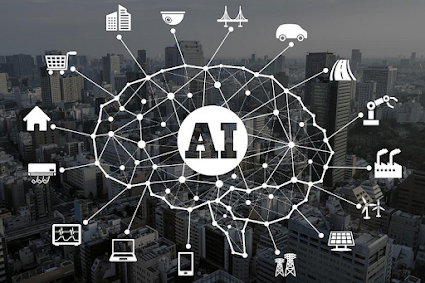Calculus: The Core of AI
Calculus in AI: The Hidden Engine Behind Smart Machines
When we think about Artificial Intelligence (AI), our minds jump to robots, self-driving cars, or smart chatbots. But rarely do we think of something as humble (and sometimes dreaded) as Calculus. Yet, behind every intelligent system, there's a math engine making it all possible—and that engine is calculus.
In this blog, we'll explore how calculus powers AI and statistics in a human-friendly way—no scary formulas, just real-world connections.
Why Does AI Need Calculus?
AI models learn by reducing errors. But how do they know how much to change, and in which direction? That’s where calculus comes in.
Just like we adjust our actions based on outcomes, machines do the same—only they use calculus to guide them. Whether it’s optimizing predictions or updating weights in neural networks, calculus is the secret sauce.
The Many Roles of Calculus in AI and Statistics
Here are ten key ways calculus is used in AI, explained in simple terms:
1. Derivatives – Measuring Sensitivity
A derivative tells us how one thing changes when something else changes.
In AI, it helps measure how much the error changes when a weight in the model changes. This is crucial for learning.
Example: If your AI model is predicting house prices, a derivative tells it, “If you change this parameter slightly, the error will go up/down by this much.”
2. Gradient – The Direction of Change
A gradient is a set of derivatives—one for each parameter in the model. It points in the direction of steepest increase or decrease in error.
Think of it like a compass showing the model where to go to improve its accuracy fastest.
3. Gradient Descent – How Machines Learn
This is the algorithm most machine learning models use to learn.
The model looks at the gradient and takes a small step in the opposite direction to reduce the error. This is repeated until the model becomes accurate.
It’s like walking downhill blindfolded by feeling the slope with your feet—one cautious step at a time.
4. Backpropagation – Training Neural Networks
Neural networks learn by passing information forward and then using backpropagation to send the error backward.
Backpropagation uses the chain rule of calculus to figure out how much each neuron contributed to the error so it can fix it.
Imagine blaming each team member for a group mistake and helping them improve individually.
5. Loss Functions – Calculating Error
To learn, a model must know how wrong it is. That’s done through a loss function (like Mean Squared Error).
These functions are differentiable, meaning we can use calculus to figure out how to reduce the error.
Without calculus, the model wouldn’t know how to improve.
6. Activation Functions – Introducing Non-Linearity
Functions like sigmoid, tanh, and ReLU are used in neurons to decide whether to activate or not.
These functions must be differentiable so that their gradients can be calculated during learning.
They are like decision-makers in the machine’s brain—calculus helps fine-tune those decisions.
7. Integrals – For Probabilities and Continuous Distributions
In statistics and AI, we often deal with probabilities. Calculus helps us integrate over probability distributions to get meaningful results.
For example, computing the total probability of an event occurring in a certain range requires finding the area under a curve using integration.
8. Regularization – Preventing Overfitting
Sometimes, models learn too much from training data and perform poorly on new data.
Regularization techniques (like L1 or L2) add penalties to large weights. These penalties are calculated using calculus, ensuring the model doesn’t become overly complex.
It’s like encouraging a student to focus on key concepts, not memorize everything.
9. Likelihood and Expectation – Statistical Learning
In Maximum Likelihood Estimation (MLE) and Bayesian models, calculus helps maximize or integrate over likelihood functions.
This helps in finding the best parameters for probabilistic models.
For instance, in logistic regression, we use calculus to maximize the likelihood that the model predicts the correct class.
10. Differential Equations – Modeling Real-World Systems
In advanced AI applications like robotics or self-driving cars, we often deal with real-world systems that change continuously over time.
These are modeled using differential equations, which are a central part of calculus.
Whether it’s controlling the speed of a robot or adjusting a drone’s flight path, calculus makes it happen.
Final Thoughts: Calculus is the Lifeblood of AI
Even if you never directly write an integral or derivative while building an AI model, calculus is always there—powering learning, optimization, and prediction.
Think of it like oxygen for intelligent systems. You may not see it, but without it, AI wouldn’t breathe.
Summary Table
| Concept | Role in AI |
|---|---|
| Derivatives | Measure change in error |
| Gradients | Guide model direction |
| Gradient Descent | Help model learn by minimizing loss |
| Backpropagation | Train deep neural networks using chain rule |
| Loss Functions | Quantify how wrong a prediction is |
| Activation Functions | Learn non-linear patterns and make decisions |
| Integrals | Handle probabilities and continuous data |
| Regularization | Prevent overfitting with smooth weight control |
| Likelihood & Expectation | Choose best model parameters statistically |
| Differential Equations | Control time-based, real-world systems |
Conclusion:
Calculus isn't just math—it's the foundation that lets AI systems learn, adapt, and improve. Whether you're a student, AI enthusiast, or future data scientist, having a grip on these ideas will make your journey smoother and more insightful.


.png)
.jpg)
Comments
Post a Comment